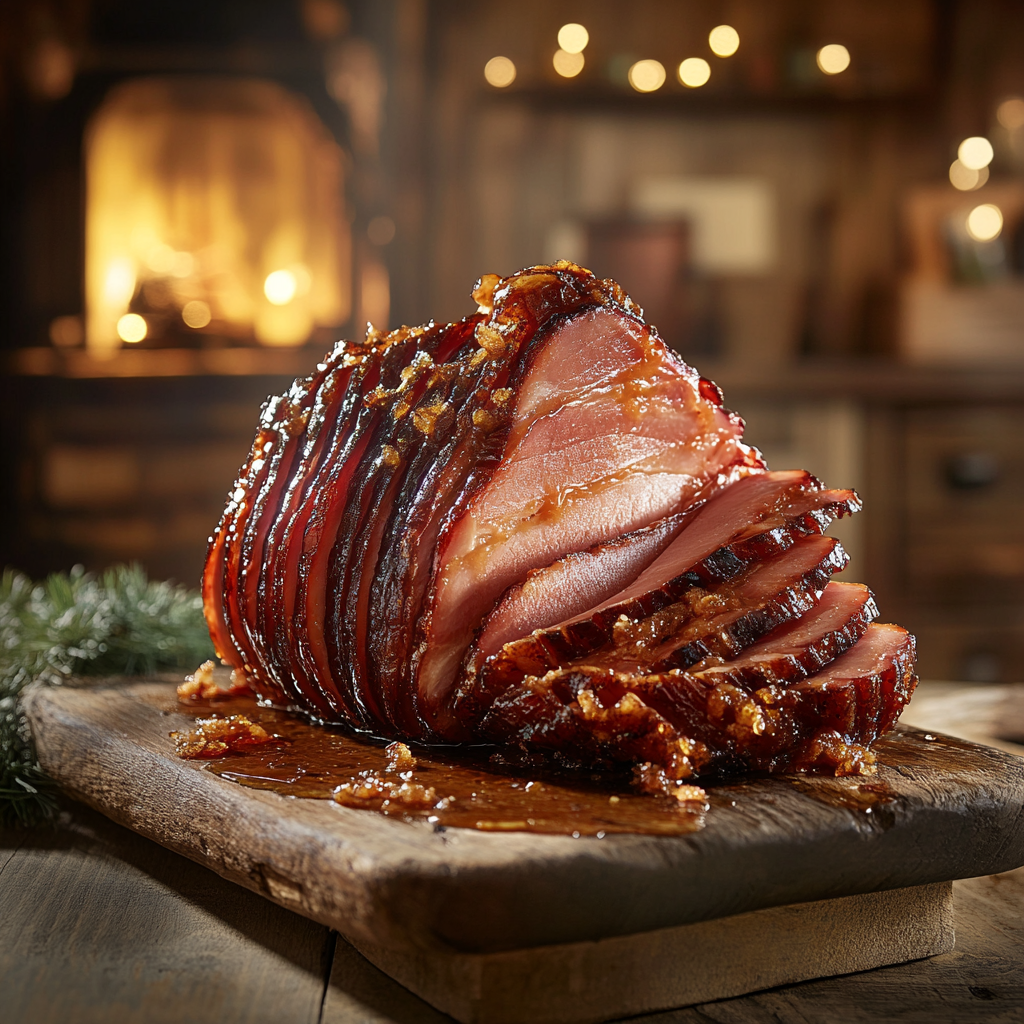There’s something unforgettable about the first time I tasted a properly smoked ham. I was maybe eight, standing barefoot on my grandmother’s kitchen tiles, the windows steamed up from everything bubbling on the stove. In the corner sat a glossy, golden-brown ham—its scent wrapping around the room like a cozy blanket. That was the first time I realized that a smoked ham recipe wasn’t just about meat. It was about memory, laughter, and the kind of love that shows up on a plate.
Over the years, I’ve learned to recreate that same rich, savory flavor in my own kitchen—with a few shortcuts that respect both tradition and time. Smoking a ham at home might sound like something reserved for BBQ pitmasters, but it’s absolutely doable in a backyard or even with a basic pellet smoker. And let me tell you—once you taste the deep smokiness mingled with sweet, sticky glaze, you’ll never go back to the store-bought version again.
This smoked ham recipe has become a go-to for my holiday gatherings, weeknight splurges, and even casual Sundays where I just want the house to smell like something special is happening. It’s simple, it’s hearty, and most importantly—it brings people together.
Whether you’re hosting Easter brunch or planning leftovers for the week, this guide will walk you through exactly how to make smoked ham that tastes like it came from a professional smoker—but with simple steps you can do at home. You’ll learn how to follow this smoked ham recipe to get that perfect balance of tradition and taste.
Table of Contents
Choosing and Preparing Your Ham
The best type of ham for smoking
Not all hams are created equal when it comes to smoking. If you’ve ever stood in the meat aisle feeling overwhelmed, I’ve been there too. The best smoked ham recipe always starts with choosing the right cut.
Look for a bone-in, fully cooked ham—either whole or half, depending on how many you’re feeding. Bone-in adds extra flavor and moisture as it cooks, especially during the long, slow smoking process. If you can find a shank-end cut, it’s usually easier to carve and gives that classic ham shape everyone loves to see on the table.
You’ll also notice some hams are labeled “smoked” or “hickory-flavored.” These are usually already partially smoked and can be double-smoked at home for deeper flavor. Avoid spiral-cut hams for smoking—they tend to dry out. Instead, choose an unsliced option and let your smoker work its magic.
Want to take it to the next level? Try pairing your smoked ham with a savory side like this chicken pot pie casserole for a comfort-food dinner that feels like home.
Essential prep steps before you smoke
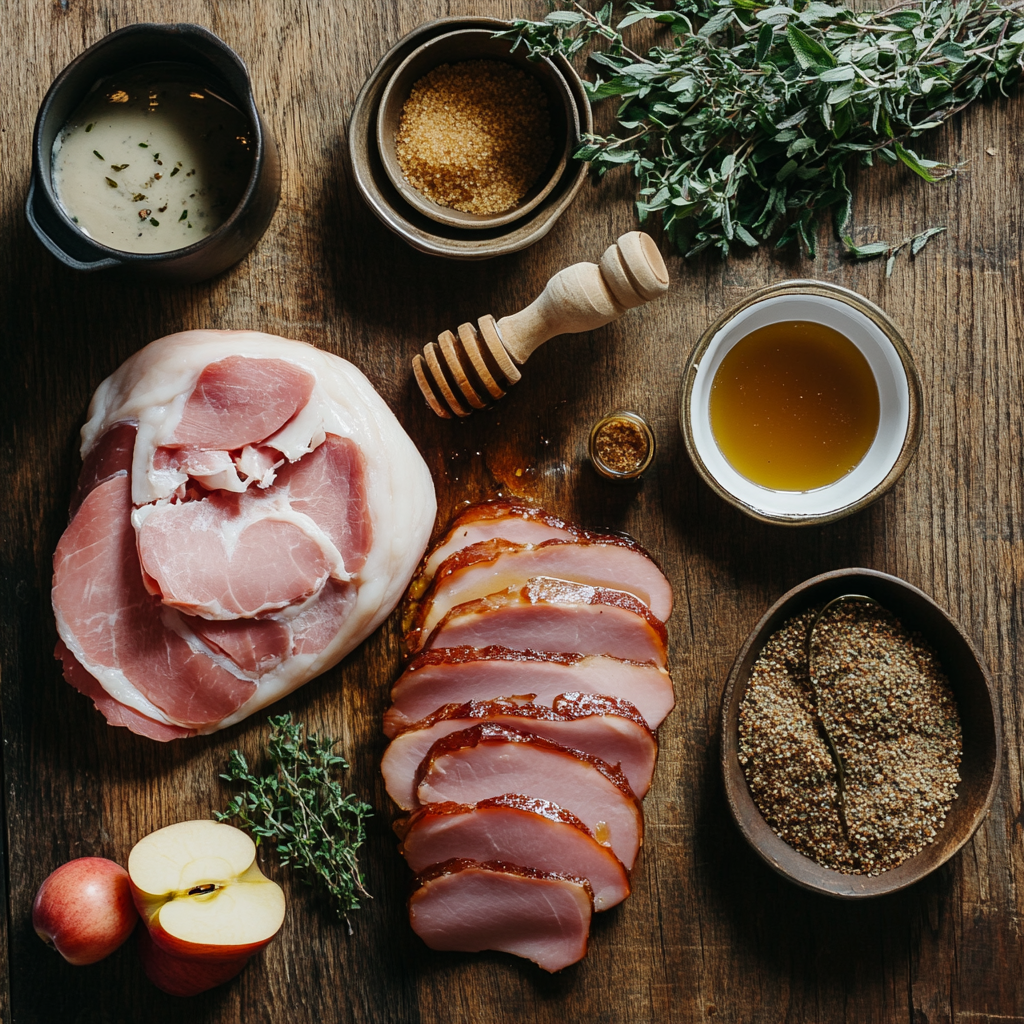
Here’s where the flavor magic begins. Before your ham even sees the smoker, it needs a little prep.
Scoring the surface: Using a sharp knife, gently score the outer fat in a diamond pattern. This not only looks beautiful but helps your seasoning and glaze soak into every bite.
Dry rub or mustard base: I like to rub a thin layer of Dijon mustard over the surface—don’t worry, it won’t taste like mustard. It acts like glue for your seasoning. Then I sprinkle on a simple mix of brown sugar, paprika, garlic powder, and a touch of cayenne for a gentle kick.
Let it rest: After seasoning, let the ham sit at room temperature for 30–60 minutes before placing it in the smoker. This helps it cook more evenly and keeps it juicy.
For more hearty breakfast options using ham leftovers, check out these delicious breakfast sausage recipes—a great way to stretch your smoked ham into the week.
Smoking Techniques and Glazing
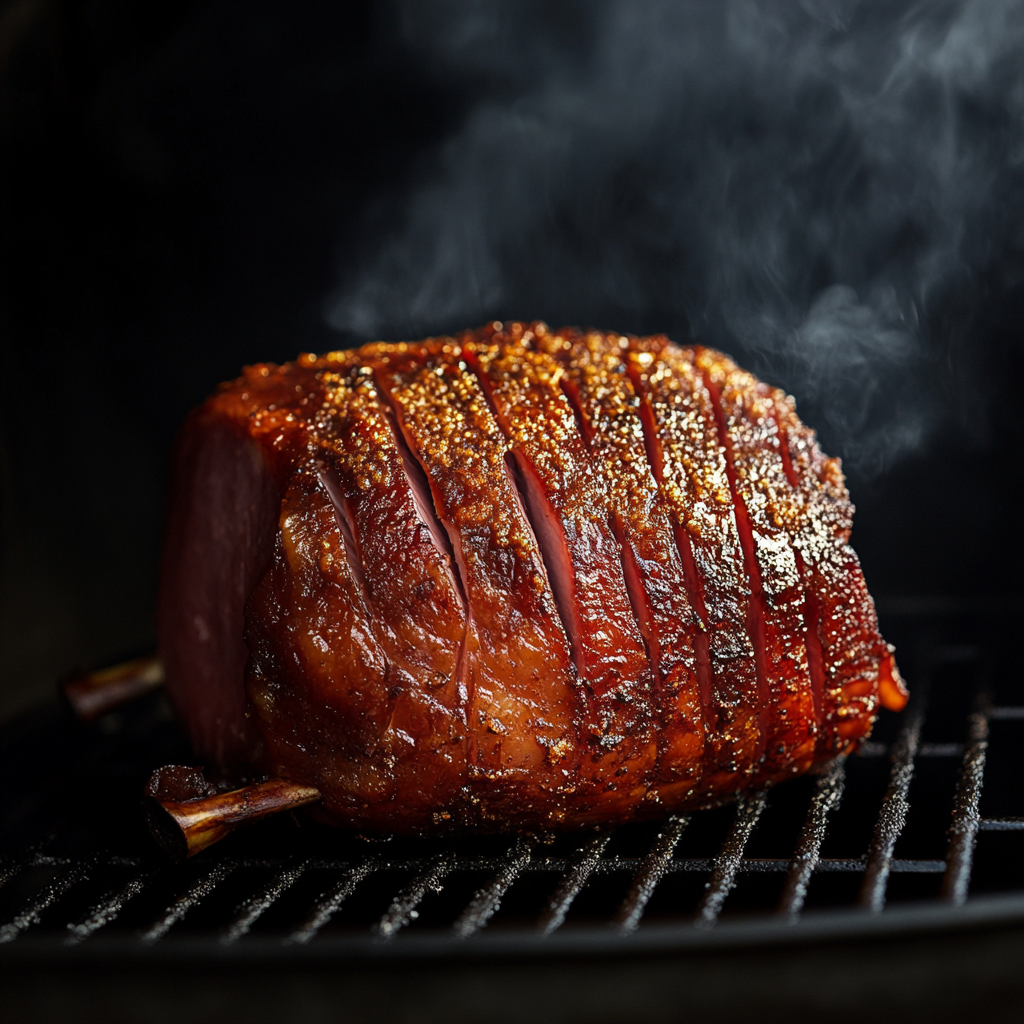
How to smoke ham the easy way
You don’t need to be a BBQ champ to smoke a ham that turns heads and wins hearts. Honestly, with just a little prep and a reliable smoker, you’ll have this smoked ham recipe down pat in no time. This smoked ham recipe works for beginners and seasoned home cooks alike.
Start by setting your smoker to 225–250°F. You’ll want to use indirect heat, so if you’re working with a charcoal grill or traditional smoker, place your coals to one side and the ham on the opposite. For wood, cherry and apple are my top picks—they add just the right amount of sweetness and depth without overpowering the meat.
Place your prepped ham directly on the smoker grates, flat-side down if it’s a half ham. Let it bathe in that fragrant smoke for about 2 to 3 hours, depending on size. If you’re using a pre-cooked ham (which most store-bought hams are), you’re essentially reheating it with flavor. The goal is an internal temperature of 140°F at the thickest point.
And here’s a tip: Don’t open the lid too much. Every peek lets out precious heat and smoke, which could throw off your cooking time. Trust the process and keep your smoker steady.
Pair your smoked ham with something vibrant and savory like this crowd-pleasing crack green beans recipe or prep ahead a batch of breakfast pizza rolls for tomorrow’s leftovers.
Creating a show-stopping glaze
Now, let’s talk about that glaze—because it’s one of the finishing touches that sets this smoked ham recipe apart from the rest.
This is my go-to glaze:
- ½ cup brown sugar
- ¼ cup honey
- 2 tablespoons Dijon mustard
- ¼ cup apple cider
- Pinch of ground cloves (optional but amazing)
Mix everything in a small saucepan over medium heat just until it’s warm and syrupy. You’re not trying to cook it, just dissolve the sugar and let the flavors come together.
After your ham has been smoking for a couple of hours, and is around 120–125°F internally, it’s glaze time. Baste the ham generously with your glaze, making sure to get into those scored crevices. Then, smoke it for another 30 to 45 minutes, basting once more halfway through. This will create a glossy finish that caramelizes perfectly.
If you want more insight into how glazing works with smoking, this guide from BBQ Champs Academy breaks it down beautifully with expert tips and flavor combos.
You can even finish it off under a broiler for 2–3 minutes if you want an extra sticky top—but keep a close eye so it doesn’t burn.
If you’re feeling adventurous, use your leftover glaze as a dipping sauce or drizzle it over easy ham and cream cheese pinwheels for a quick snack that disappears fast at parties.
And if seafood’s on your mind for your next gathering, don’t miss this simple lobster tail cooking guide—a perfect contrast to your smoky centerpiece.
Serving, Storage, and Leftovers
Best ways to slice and serve smoked ham
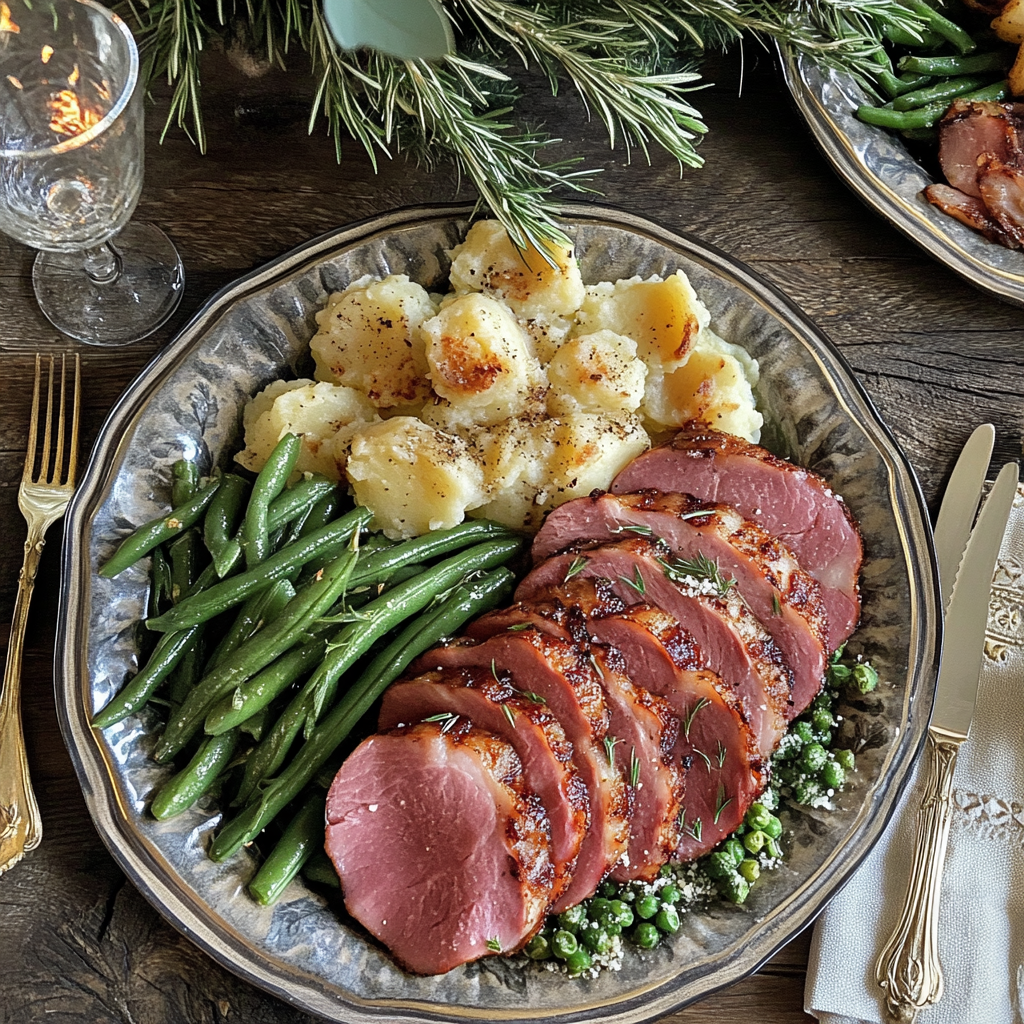
So, your smoked ham is glistening, caramelized, and filling the kitchen with mouthwatering aromas. It’s time to slice and serve your smoked ham—but how you do this can make a big difference. One reason this smoked ham recipe stands out is how it locks in moisture while building layers of flavor.
Start by letting your ham rest for 15 to 20 minutes after taking it off the smoker. This helps the juices settle and keeps every slice tender. Use a sharp carving knife and begin slicing at the shank end, cutting parallel to the bone for clean, uniform pieces.
For presentation, fan out the slices on a large platter. Sprinkle on some fresh herbs—like thyme or parsley—and pair it with sides that complement its smoky-sweet flavor. One of my favorite combos? A hearty scoop of scalloped potatoes and ham with a spoonful of tangy mustard on the side. It’s the kind of comfort food that brings folks back for seconds.
That’s the beauty of following a smoked ham recipe built for both flavor and simplicity.
Smart storage and leftover ideas
One of the best things about this smoked ham recipe is that it creates amazing leftovers.
First, make sure the ham cools completely. Then slice or cube the meat and store it in an airtight container. It’ll keep in the fridge for up to 4 days or in the freezer for 2 to 3 months.
Here are a few of my favorite ways to use up leftover smoked ham:
- Ham and cheese pinwheels: These little bites are great for lunchboxes or quick snacks. Wrap diced ham with cream cheese and tortillas, then slice into rounds. Here’s a full recipe you’ll love.
- Ham-stuffed breakfast burritos: Wrap scrambled eggs, ham, and cheddar in a warm tortilla. Freeze and reheat for an easy morning win.
- Ham in pasta or soups: Add to mac and cheese, creamy potato soup, or stir into scrambled eggs for a quick and tasty twist.
And if you’re ever stuck with “too much ham,” just chop it up and toss it into your next batch of breakfast sausage—the smokiness adds such great depth.
Save this smoked ham recipe for holidays, meal prep, or even a cozy weekend brunch
FAQs and Conclusion
What is the best way to cook smoked ham?
The best way to cook smoked ham is low and slow in a smoker. Using indirect heat around 225–250°F and your choice of fruit wood (like cherry or apple) gives the ham its signature deep, smoky flavor. Apply a sweet glaze in the last hour to create a caramelized finish. This smoked ham recipe brings out all the richness of the meat while locking in moisture.
How long does a smoked ham need to be cooked?
For a pre-cooked bone-in ham, smoking usually takes about 3 to 4 hours, depending on its size. You’re aiming for an internal temperature of 140°F. Be sure to let it rest for 15–20 minutes before slicing for best results. For this smoked ham recipe, 3 to 4 hours is the sweet spot.
How do you eat smoked ham?
Smoked ham can be enjoyed warm right off the smoker or served cold the next day in sandwiches, wraps, or breakfast dishes. Thanks to the smoky-sweet finish of this smoked ham recipe, it fits beautifully in salads, pasta, or sandwiches.
How is a smoked ham made?
Smoked ham starts with a cured and sometimes pre-cooked cut of pork, typically from the hind leg. The ham is then seasoned, scored, and placed in a smoker with wood chips. Over several hours, it absorbs smoky flavor while slowly reheating. The process finishes with a sweet glaze that caramelizes on the surface, creating that golden, sticky crust everyone loves.
Conclusion: A Recipe Worth Sharing
Bringing a smoked ham recipe to your table isn’t just about flavor—it’s about tradition, comfort, and creating something truly memorable. Whether you’re gathering family for the holidays or just want a hearty Sunday dinner, smoked ham is always a good idea.
It’s simple, satisfying, and smells like celebration. And once you’ve made it once, you’ll want to keep this recipe close for years to come.
Print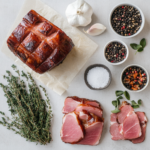
Smoked Ham Recipe
- Total Time: 3 hours 20 minutes
- Yield: 8 servings 1x
Description
This smoked ham recipe combines rich, smoky flavor with a sweet brown sugar glaze. Perfect for holidays, brunch, or a hearty dinner, it’s easy to make and always a crowd-pleaser.
Ingredients
- 1 fully cooked bone-in ham (8–10 lbs)
- ½ cup brown sugar
- ¼ cup honey
- 2 tablespoons Dijon mustard
- ¼ cup apple cider
- Pinch of ground cloves (optional)
- Optional rub: 1 tbsp paprika, 1 tsp garlic powder, ½ tsp cayenne
Instructions
- Score the ham’s surface in a diamond pattern.
- Rub with Dijon mustard and season with optional rub mix.
- Preheat smoker to 225–250°F using cherry or apple wood.
- Place ham on smoker and cook for 2–3 hours.
- In a saucepan, combine brown sugar, honey, mustard, and cider. Warm until smooth.
- Baste ham with glaze once it reaches 120–125°F.
- Continue smoking another 30–45 minutes until ham reaches 140°F internal temp.
- Optional: Broil 2–3 minutes for extra caramelization.
- Let rest 15–20 minutes before slicing and serving.
Notes
- Spiral hams may dry out—use unsliced bone-in for best results.
- Let the ham rest to retain juices.
- Leftovers are great in soups, pastas, or breakfast burritos.
- Prep Time: 20 minutes
- Cook Time: 3 hours
- Category: Main Course
- Method: Smoking
- Cuisine: American
Keywords: smoked ham recipe

